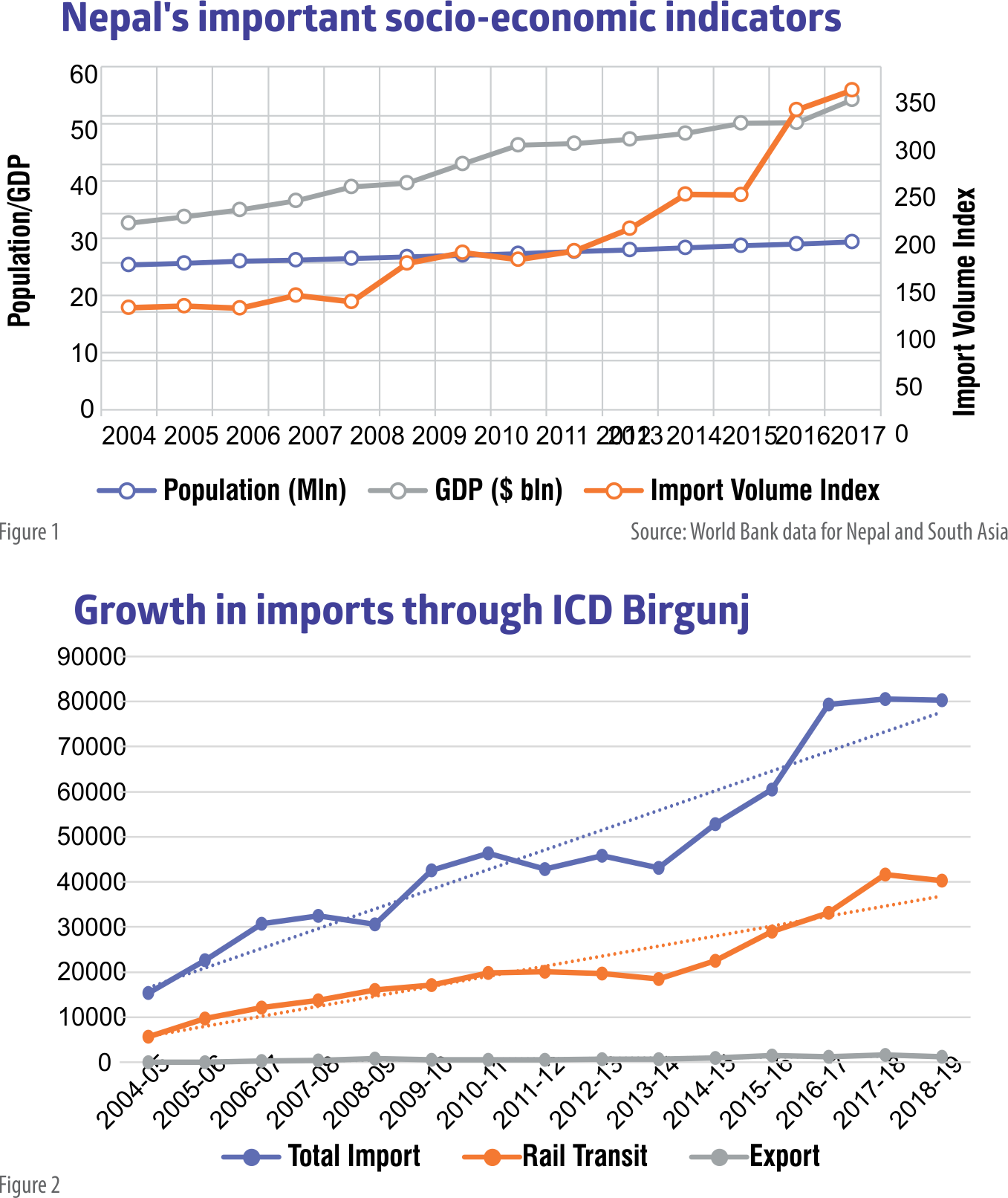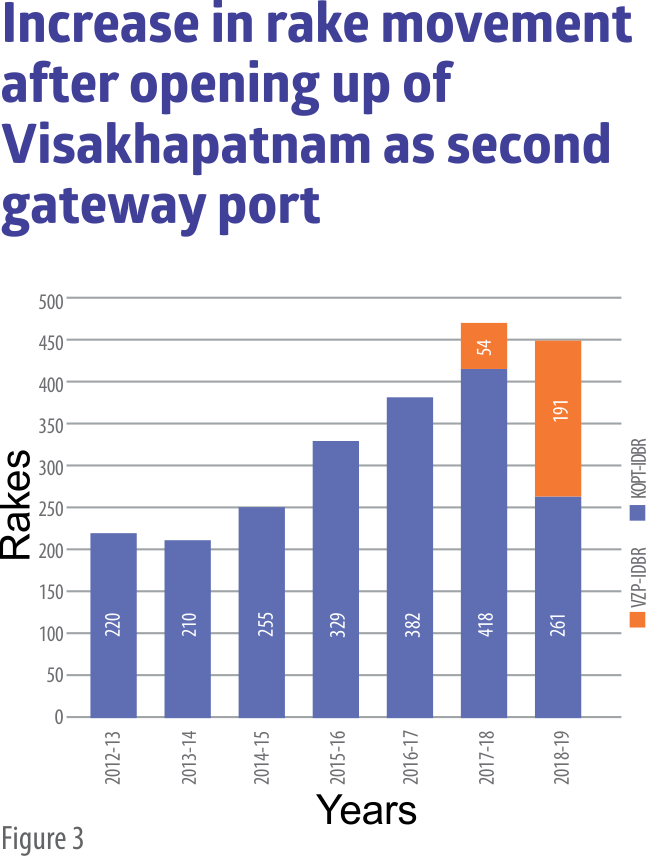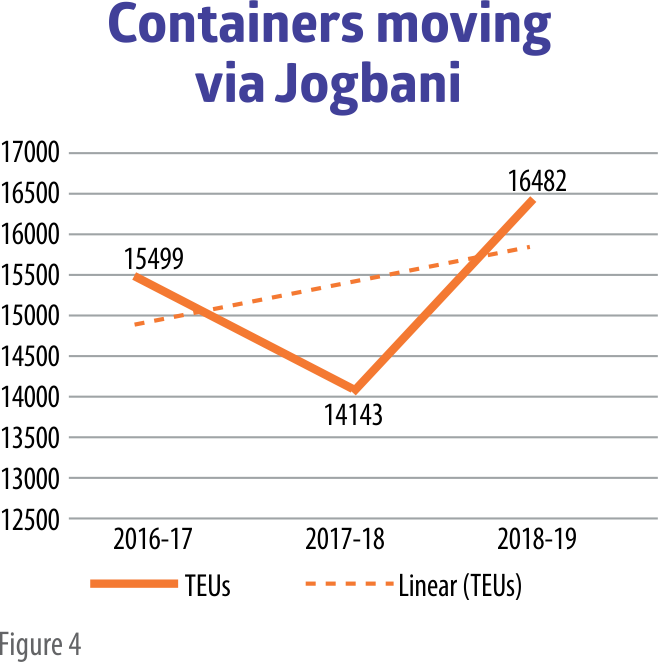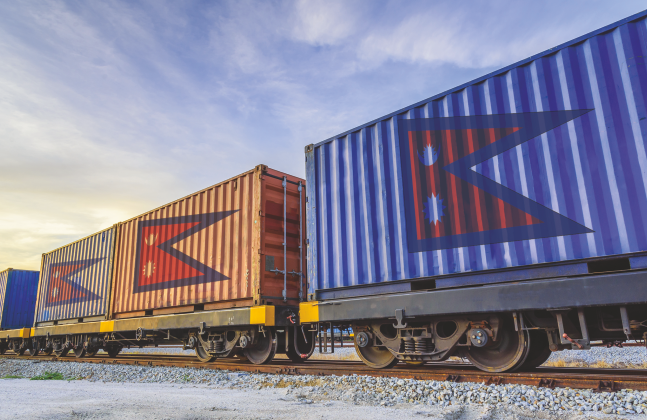Third country imports in Nepal are expected to grow in future and CONCOR is ready with its world class services to serve the trade in the most efficient and cost effective manner
Container Corporation of India Ltd. (CONCOR) has been at the forefront in providing seamless and efficient transit service to Nepal through the gateway ports of Kolkata, Haldia and Visakhapatnam. With a humble beginning in the year 2004-05, CONCOR has been since keeping pace with the growing demand of consumer goods in Nepal spurring import. Standing shoulder to shoulder with the government and importers of Nepal, CONCOR has been relentlessly serving their interests and has always come up trumps in meeting their growing aspirations. Besides partaking in development of the dry port at Birgunj, what is now known as Himalayan Terminal Private Ltd. (HTPL), the biggest dry port in Nepal, CONCOR has been operating the facility since its inception, has infused more rolling stocks, has taken initiatives to open new gateway ports and delivery points and has eased the transit procedures through IT solutions, such as KYCL (Know Your Container Location), and recently by supporting Government’s initiative to introduce ECTS (Electronic Cargo Tracking System), which has flattened the procedural hurdles and given end to end container visibility.
As the growth in demand is expected to continue, a few infrastructure development initiatives will have to be quickly undertaken by the government of Nepal in partnership with Govt. of India and important stakeholders, such as CONCOR and NITDB.
Import and export
Considering the year 2000 as the base year World Bank has developed an ‘Import Index’ which starting from 100 in the year 2000 reached the scale of 325 in the year 2017. This spectacular rise possibly piggybacked on GDP growth (or probably led to it) which rose from $5.5 billion in 2000 to $24.8 billion in 2017, approximately 4X growth in 17 years. A simple regression shows a very positive correlation between the GDP and import volumes. If we try to find an elasticity value, although any econometric operation on less than 30 data points is unlikely to be statistically significant, a two variable regression shows an elasticity of import volume of 0.86 with respect to GDP which is quite high and more or less in the statistically acceptable range. The meaning of this value is that a one percent increase in GDP will cause 0.86 per cent increase in import volume. This elasticity value, however, needs to be econometrically validated with more data points and multiple variables but it does give a sense of relationship between GDP and import volumes in Nepal.
Three important indicators that are also major drivers of import are plotted in Figure 1, showing their interdependent relationship and the interplay over the period from 2004 to 2017. An important point to note in the graph is increase in growth rate of import into Nepal from the year 2008 which possibly is an effect of HTPL and start of train operation between KoPT and Birgunj.
A quick look at the Figure2 reveals how fast the imports into Nepal through HTPL have grown. From approximately 5000 teus in 2004-05 the volume has jumped to a whopping figure of approximately 41000 teus. A CAGR of around 16.5 per cent is impressive by any standard and this phenomenal growth rode on CONCOR’s back. The linear trend line’s sharp northward rise (Fig. 2) would demand marshalling of huge resources, particularly rolling stocks, year on year, at an increasing pace.
Total imports into Nepal grew even faster in the corresponding period as the expanding gap between the two trend lines would suggest. When HTPL started its operations in the year 2004- 05 the total import was about 15,000 teus but it was well above 80,000 teus in 2018-19. The CAGR of 13.5 per cent may not look comparable to the CAGR of rail-based transportation to HTPL but we should not miss the point that the rail transportation had a very low base to begin with.

CONCOR’s initiatives
Since inception CONCOR has been taking initiatives to make the transit more efficient and cost effective and to this end it has pressed into service high speed BLC rakes in KoPT – BGJ corridor, ensured reliability in placement of rakes at Port, has been continually increasing the number of rakes from 4-5 to 10-12 and now to 20 rakes, reduced rates for low weight traffic, i.e., up to 10mt category, allowed private road transportation arrangement at both Birgunj and Majerhat terminal at Kolkata to expedite the delivery process and passed on the benefit to importers for utilization of same containers for export boxes by way of refunding the empty container freight from BGJ to Kolkata. In the recent days CONCOR has taken a few more steps to save importers’ costs by facilitating container drop off at HTPL and eventually by coordinating with the shipping lines to issue Bill of Lading (BL) up to Birgunj. High capacity and fast moving BLC wagons with gross carrying capacity of 34 tons per teu have been inducted into the circuit to bring the unit cost down and to easily carry the heavier containers.
Recently CONCOR actively participated in the efforts of ADB to introduce ECTS for the rail bound transit containers and coordinated with the Govt. of Nepal, Kolkata Port Trust, Customs, importers and other stakeholders. ECTS is expected to bring in efficiency and transparency in the entire supply chain by cutting the procedural delays, reducing paper works, bringing down dwell time at the port after landing, saving time and costs and providing cargo visibility to the importers and the shipping lines helping not only the Customs in ensuring safe passage of containers to Nepal but also the importers in planning timely delivery of the cargo on arrival. It helps them prepare themselves in time eventually reducing detention charges and giving better control on the inventory. The practical gateway port is now ICD Birgunj up to where the Shipping lines bring the containers on their own risk, paying the inland haulage charges to CONCOR. They issue DOs for releasing the containers at HTPL and receive the containers at HTPL possibly reducing the detention to null which used to be a huge financial drain on the importers.

With growing imports, Visakhapatnam Port was opened as another gateway port by amending the RSA which increased the total rail-bound traffic to Nepal without increasing the cost as the lines introduced better deals by integrating the ocean freight with IHC and offering a cost effective package to the importers. Visakhapatnam started as an additional gateway port in the month of June 2017 but it gathered momentum only in January 2018. Effect of this new port on the total volume can be seen in Figure 3, which shows a sudden jump in import from 382 rakes in 2016-17 to 472 rakes in 2018-19.
With growing imports, Visakhapatnam Port was opened as another gateway port by amending the RSA which increased the total rail-bound traffic to Nepal without increasing the cost as the lines introduced better deals by integrating the ocean freight with IHC and offering a cost effective package to the importers. Visakhapatnam started as an additional gateway port in the month of June 2017 but it gathered momentum only in January 2018. Effect of this new port on the total volume can be seen in Figure 3, which shows a sudden jump in import from 382 rakes in 2016-17 to 472 rakes in 2018-19.
Transit time and cost savings
The volume of rail bound containers to Birgunj grew about 8 times in the last 14-15 years on the same rail network and route but the transit time has been reducing, albeit slowly, instead of increasing as it should generally happen with increasing volume on the same route. Similarly, the cost of transportation through rail has been much lower than the road, especially in the 26 tonnes and above weight category. Average cost saving per teu on transportation is approximately Rs.10,000/- which multiplied with the volumes per annum would give an idea of cost savings that Nepalese importers have been able to achieve by using CONCOR’s services.
Terminal at Kurtha Kurtha
in Nepal is likely to be connected by rail with Jaynagar railway station in Samastipur Division of E.C Railway, India. Jaynagar-Bardibas section between India and Nepal will be a broad gauge connection passing through Janakpura and Kurtha in Nepal. The first phase of section up to Khurtha is likely to be commissioned in the current financial year. Kurtha is located between two important consumption and industrial clusters of Nepal, i.e., Biratnagar and Birgunj catering to the areas that are currently not served by the two LCSs located at these clusters. CONCOR can partner with the Napalese agencies to develop the terminal. The following two implementation models can be considered by the decision makers: a) A JV can be formed following the HTPL model with partners from both the countries with management control of CONCOR, or b) HTPL can invest and develop the facility as a second terminal complementing the terminal at Birgunj.
Container Terminal at Biratnagar

The work of laying railway line is under progress and it is expected to be completed by the year end. The work of Indian Customs Yard and Nepal Customs Yard is under construction and the same is also expected to be completed by this year end. Biratnagar is one of the important towns of Nepal and at present all traffic is moved by road through ICP and LCS at Jogbani in India and through LCS at Biratnagar in Nepal. The road is very congested and vehicles are detained near LCS for a long time. By developing this facility, containers can be easily moved to Biratnagar bypassing the existing LCSs. The Railway station of Biratnagar (On Nepal side) is ready. The goods line is yet to be made ready for operation and the adjoining platform would have to be developed with concrete CC blocks for RST operation. The same models as suggested above could be adopted for Biratnagar container terminal as well.
Expansion of ICD Birgunj
At present HTPL terminal at Birgunj has only one line to handle container trains which is proving inadequate as the number of trains to HTPL is steadily increasing. If the number goes above 60 it will be highly impossible to handle container trains at Birgunj. One more container line must be added in order to take the import and handling to the next level. Indian Railways are electrifying the entire section up to Raxaul and several stretches are being doubled. If HTPL does not respond in time in terms of expansion of its handling capacity, it will become a bottleneck in itself. The line between Raxaul and Birgunj will also have to be electrified to allow the Indian Railways to use incoming locomotives right up to the HTPL terminal.
Opening of border at Nautanva
Nautanva – Bhairawah LCS is also emerging as important transit location for import cargo in general and containers in particular. Indian Railways have agreed to open Nautanva as a container handling point for containers in transit to Nepal. This permission can be gainfully utilized by Nepal trade without investing into any infrastructure for the time being. Indian Railways’ goods shed of Nautanva can be availed for the purpose.







